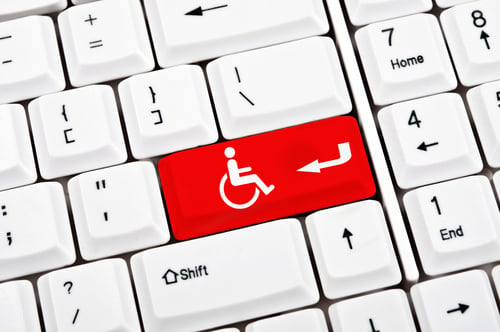Law Scribbler

Jason Tashea. Photo by Saverio Truglia.
When it comes to making the law more accessible online, few can claim a longer history than Cornell University Law School’s Legal Information Institute.
Since its founding in 1992, the LII has undertaken many notable projects, including republishing the Code of Federal Regulations, running a legal encyclopedia for quick definitions and understanding of legal topics, and conducting research into the readability of the law.
Now, the organization is taking a step back and looking at its online infrastructure to make sure its content can be accessed by all people, including those with disabilities. They intend to have the project completed by the end of the year.
“It’s ambitious,” says Sara Frug, associate director for technology at the LII.
To accomplish this, Frug and her team will implement the Web Content Accessibility Guidelines (WCAG) 2.0 AA, considered the “gold standard” in Europe and the U.S. for online accessibility.
Meeting these standards will help the blind, who use screen readers, understand text and images on a screen, and assist those that can’t use a mouse by making the site navigable by keyboard, for example.
Only a month into the project, it “has raised our own awareness about the ways in which there are a lot of impediments,” says Frug, who hopes their experience will help others think of web accessibility as a best practice that improves innovative, online resources.
Bringing attention to the issue is desperately needed in the legal profession, where online accessibility is far from the norm.
As legal services providers update their technology and grow their online footprints, they should build and use technology that is accessible to the broadest number of people. Doing so will increase office productivity, client and employee retention and save firms money by not engaging in piecemeal accommodation.
The importance of online accessibility is heightened for law firms due to increased online interaction between lawyers and clients, says Robert Gonzales, chair of the ABA’s Commission on Disability Rights.
Even so, the issue has not been on the front burner in the legal industry, in part because of its lack of diversity. While the profession needs to capture better data on disabilities and firms’ compliance with relevant laws, the best numbers say that one-half of 1% of partners and associates have disabilities, according to the National Association of Law Placement’s 2018 Report on Diversity in U.S. Law Firms. This number may be low, as the report indicates that about 2% of law school graduates have a disability. Nationally, 1 in 5 people have a disability.
In this ecosystem, legal technology companies are—self-admittedly—missing the mark. In 2016, the ABA Commission on Disability Rights surveyed the 120 vendors at ABA Techshow. Of the 79 respondents, only eight indicated their software was accessible to those with disabilities.
Law firms are not that much better, according to Gonzales. Even when firms do take a step toward accessibility, it’s usually reacting to an individual request, he says.
Another reason for slow adoption of web accessibility standards is that the law is unclear. Legally, there’s a federal circuit court split over whether the Americans with Disabilities Act of 1990, which is used to decrease physical barriers that impede the disabled, applies to internet technologies. At issue is whether a website is a “public accommodation,” like a store or hotel.
 Image from Shutterstock.com.
Image from Shutterstock.com.The 1st, 2nd and 7th Circuit Courts of Appeals say that a website can be a place of public accommodation regardless of any connection to a physical space, according to a recent article by Jason Brown, an associate at Hunton Andrews Kurth in Washington, D.C. By comparison, the 3rd, 6th, 9th, and 11th Circuit Courts of Appeals have held that a website is not a public accommodation, unless it has a sufficient connection to a physical public accommodation.
Without U.S. Department of Justice guidance on the issue, more suits are likely. However, this did not stop the ABA House of Delegates from getting out in front of the issue in 2018 with House Resolution 116C, which called for parts of the ADA to apply to technology regardless of its nexus to a physical space.
Not just the right thing to do, the House’s resolution makes smart business sense. According to a 2018 report from Accenture, 45 companies they identified as standouts in disability employment and inclusion, of which technology accessibility is included, had 28 percent higher revenue and a 30 percent better profit margin performance than their competitors.
“If you’re not available—if you’re not accessible—you’re not reaching that market,” Gonzales says. After Hispanics and African-Americans, disabled people are the third-largest market segment in the country, according to a 2018 report from the American Institutes for Research.
Not just for those with disabilities, web accessibility is good from a marketing perspective generally. As more people go online to find legal help, a law firm needs to be high in search engine results to be found. Frug at Cornell notes that to make its website WCAG compliant, her team will make the website more machine readable and easier to index, two things that boost a website’s search engine optimization, which helps it climb in search results.
Within a firm, it’s possible that employees that need accommodation aren’t coming forward, Gonzales says, which means the firm is losing productivity and otherwise strong workers may leave for a more accommodating workplace.
While the business case for web accessibility is strong, it can still be overwhelming on where to start. Organizations like UsableNet and My Blind Spot offer WCAG auditing services and other resources, according to Robert Furnier, director of Lunsford Academy at the Chase College of Law at Northern Kentucky University and former chair of diversity and inclusion for the ABA Law Practice Division. Frug at Cornell likes the University of Washington’s Accessible Technology website as a resource.
For Gonzales, he says that many technology vendors have accessibility options but don’t often market them. He recommends that when a firm is considering new technology that it ask the vendor to make the tool accessible to everyone at the time of installation, saving money and time down the road.
Having worked with multiple firms to improve their online accessibility, he says the updates have never been cost prohibitive and end up saving the firm money through increased productivity, which echoes the Accenture report.
Adopting web accessibility standards helps law firms do right by their clients, employees and profitability. In the same way that a firm wouldn’t forget to install a ramp to its office’s front door, web accessibility is something the profession can no longer turn a blind eye to.
Jason Tashea is the author of the Law Scribbler column and a legal affairs writer for the ABA Journal. Follow him on Twitter @LawScribbler.